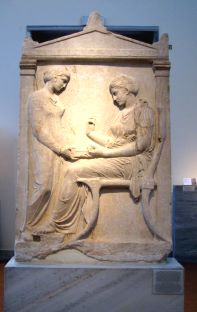The tomb relief of Hegeso, 1.52 m high, is an example of the custom that reemerged in Athens around 430/20 B.C. to decorate the tombs of rich families with reliefs, as had already been customary in archaic times. An inscription on the beam under the gable shows the name of the buried person:
Hegeso, daughter of Proxenos.
Together with some other reliefs it was discovered in 1870 in the Kerameikos of Athens on a family grave district. On the relief Hegeso is depicted as a sitting woman, who is handed a small box by a woman standing in front of her. She took something, probably a chain or a ribbon, out of the box. It was painted on the background and can no longer be seen. Hegeso is elaborately dressed in chiton and himation, while the woman in front of her is not only smaller, but also wears simpler clothes and has hidden her hair under a hood. The figures are framed on both sides by pillars carrying a gable that crowns the relief.
Tombstone exhibit of the Athens National Archaeological Museum, inventory no. 3624, replica reduction with suspension device.













